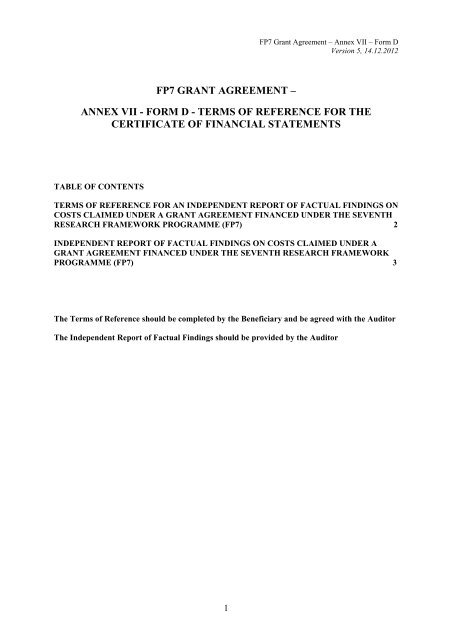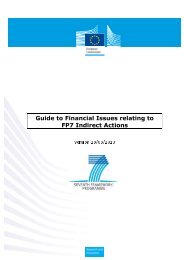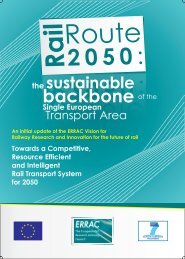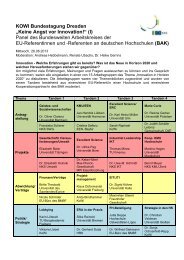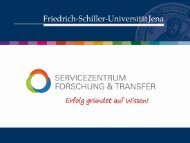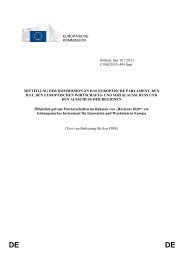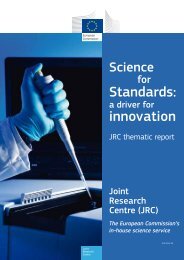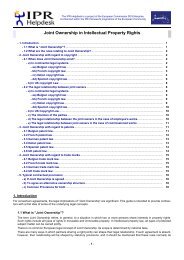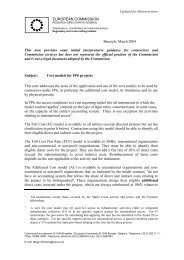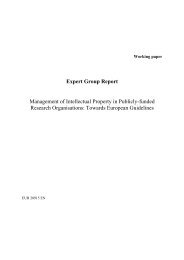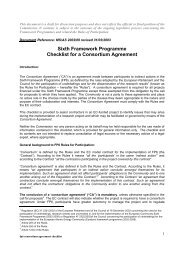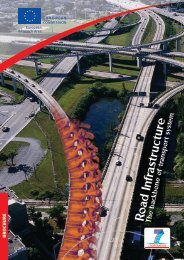FP7 GRANT AGREEMENT – ANNEX VII - FORM D ... - Europa
FP7 GRANT AGREEMENT – ANNEX VII - FORM D ... - Europa
FP7 GRANT AGREEMENT – ANNEX VII - FORM D ... - Europa
You also want an ePaper? Increase the reach of your titles
YUMPU automatically turns print PDFs into web optimized ePapers that Google loves.
<strong>FP7</strong> Grant Agreement <strong>–</strong> Annex <strong>VII</strong> <strong>–</strong> Form D<br />
Version 5, 14.12.2012<br />
<strong>FP7</strong> <strong>GRANT</strong> <strong>AGREEMENT</strong> <strong>–</strong><br />
<strong>ANNEX</strong> <strong>VII</strong> - <strong>FORM</strong> D - TERMS OF REFERENCE FOR THE<br />
CERTIFICATE OF FINANCIAL STATEMENTS<br />
TABLE OF CONTENTS<br />
TERMS OF REFERENCE FOR AN INDEPENDENT REPORT OF FACTUAL FINDINGS ON<br />
COSTS CLAIMED UNDER A <strong>GRANT</strong> <strong>AGREEMENT</strong> FINANCED UNDER THE SEVENTH<br />
RESEARCH FRAMEWORK PROGRAMME (<strong>FP7</strong>) 2<br />
INDEPENDENT REPORT OF FACTUAL FINDINGS ON COSTS CLAIMED UNDER A<br />
<strong>GRANT</strong> <strong>AGREEMENT</strong> FINANCED UNDER THE SEVENTH RESEARCH FRAMEWORK<br />
PROGRAMME (<strong>FP7</strong>) 3<br />
The Terms of Reference should be completed by the Beneficiary and be agreed with the Auditor<br />
The Independent Report of Factual Findings should be provided by the Auditor<br />
1
<strong>FP7</strong> Grant Agreement <strong>–</strong> Annex <strong>VII</strong> <strong>–</strong> Form D<br />
Version 5, 14.12.2012<br />
Terms of Reference for an Independent Report of Factual Findings on costs claimed<br />
under a Grant Agreement financed under the Seventh Research Framework<br />
Programme (<strong>FP7</strong>)<br />
The following are the terms of reference (‘ToR’) on which ‘the<br />
Beneficiary’ agrees to engage < name of the audit firm> ‘the Auditor’ to provide an independent<br />
report of factual findings on a Financial Statement(s) 1 prepared by the Beneficiary and to report in<br />
connection with a European Union/European Atomic Energy Community financed grant agreement<br />
concerning the Seventh Research Framework Programme (<strong>FP7</strong>), concerning < title and number of the<br />
grant agreement> (the ‘Grant Agreement’). Where in these ToR the ‘European Commission’ is<br />
mentioned this refers to its quality as signatory of the Grant Agreement with the Beneficiary. The<br />
[European Union] [Euratom] is not a party to this engagement.<br />
1.1 Responsibilities of the Parties to the Engagement<br />
‘The Beneficiary’ refers to the legal entity that is receiving the grant and that has signed the Grant<br />
Agreement with the European Commission 2 .<br />
• The Beneficiary is responsible for preparing a Financial Statement for the Action financed by the<br />
Grant Agreement in compliance with such agreements and providing it to the Auditor, and for<br />
ensuring that this Financial Statement can be properly reconciled to the Beneficiary’s accounting<br />
and bookkeeping system and to the underlying accounts and records. Notwithstanding the<br />
procedures to be carried out, the Beneficiary remains at all times responsible and liable for the<br />
accuracy of the Financial Statement.<br />
• The Beneficiary is responsible for the factual statements which will enable the Auditor to carry out<br />
the procedures specified, and will provide the Auditor with a written representation letter<br />
supporting these statements, clearly dated and stating the period covered by the statements.<br />
• The Beneficiary accepts that the ability of the Auditor to perform the procedures required by this<br />
engagement effectively depends upon the Beneficiary providing full and free access to the<br />
Beneficiary’s staff and its accounting and other relevant records.<br />
‘The Auditor’ refers to the Auditor who is responsible for performing the agreed-upon procedures as<br />
specified in these ToR, and for submitting an independent report of factual findings to the Beneficiary.<br />
The Auditor must be independent from the Beneficiary.<br />
• [Option 1: delete if not applicable] The Auditor is qualified to carry out statutory audits of<br />
accounting documents in accordance with the Directive 2006/43/EC of the European Parliament<br />
and of the Council of 17 May 2006 on statutory audits of annual accounts and consolidated<br />
accounts, amending Council Directives 78/660/EEC and 83/349/EEC and repealing Council<br />
Directive 84/253/EEC or similar national regulations.<br />
• [Option 2: delete if not applicable] The Auditor is a Competent Public Officer for which the<br />
relevant national authorities have established the legal capacity to audit the Beneficiary and has<br />
not been involved in the preparation of the financial statements.<br />
• The procedures to be performed are specified by the European Commission and the Auditor is not<br />
responsible for the suitability and appropriateness of these procedures.<br />
1 Financial Statement in this context refers solely to Form C - Annex VI by which the Beneficiary claims costs under the<br />
Grant Agreement.<br />
2 Where special clause 10 for the <strong>FP7</strong> Model Grant Agreement applies, or where special clause 10 bis for the <strong>FP7</strong> Marie<br />
Curie Grant Agreement applies, this Form shall be filled in also by Third Parties linked to a beneficiary. In that case, the<br />
wording "the Beneficiary" shall be read as "the Third Party".<br />
2
<strong>FP7</strong> Grant Agreement <strong>–</strong> Annex <strong>VII</strong> <strong>–</strong> Form D<br />
Version 5, 14.12.2012<br />
1.2 Subject of the Engagement<br />
The subject of this engagement is the Financial<br />
Statement in connection with the Grant Agreement for the period covering .<br />
1.3 Reason for the Engagement<br />
The Beneficiary is required to submit to the European Commission a certificate on a Financial<br />
Statement in the form of an independent report of factual findings produced by an external auditor in<br />
support of the payment requested by the Beneficiary under Article II.4 of the Grant Agreement. The<br />
Authorising Officer of the Commission requires this Report as he makes the payment of costs<br />
requested by the Beneficiary conditional on the factual findings of this Report.<br />
1.4 Engagement Type and Objective<br />
This constitutes an engagement to perform specific agreed-upon procedures regarding an independent<br />
report of factual findings on costs claimed under the Grant Agreement.<br />
As this engagement is not an assurance engagement the Auditor does not provide an audit opinion and<br />
expresses no assurance. The European Commission derives its assurance by drawing its own<br />
conclusions from the factual findings reported by the Auditor on the Financial Statement and the<br />
payment request of the Beneficiary relating thereto.<br />
The Auditor shall include in its Report that no conflict of interest exists between it and the Beneficiary<br />
in establishing this Report, as well as the fee paid to the Auditor for providing the Report.<br />
1.5 Scope of Work<br />
1.5.1 The Auditor shall undertake this engagement in accordance with these ToR and:<br />
- in accordance with the International Standard on Related Services (‘ISRS’) 4400 Engagements to<br />
perform Agreed-upon Procedures regarding Financial Information as promulgated by the IFAC;<br />
- in compliance with the Code of Ethics for Professional Accountants issued by the IFAC. Although<br />
ISRS 4400 provides that independence is not a requirement for agreed-upon procedures<br />
engagements, the European Commission requires that the Auditor also complies with the<br />
independence requirements of the Code of Ethics for Professional Accountants.<br />
1.5.2 Planning, procedures, documentation and evidence<br />
The Auditor should plan the work so that the procedures can be effectively performed. For this<br />
purpose he performs the procedures specified in 1.9 of these Terms of Reference (‘Scope of Work <strong>–</strong><br />
Compulsory Report Format and Procedures to be Performed’) and uses the evidence obtained from<br />
these procedures as the basis for the Report of factual findings.<br />
1.6 Reporting<br />
The Report of factual findings, an example of which is attached to this ToR, should describe the<br />
purpose and the agreed-upon procedures of the engagement in sufficient detail in order to enable the<br />
Beneficiary and the European Commission to understand the nature and extent of the procedures<br />
performed by the Auditor. Use of the reporting format attached as Annex <strong>VII</strong> of the Grant Agreement<br />
is compulsory. The Report should be written in the language indicated in Article 4 of the Grant<br />
Agreement. In accordance with Article II.22 of the Grant Agreement, the European Commission and<br />
the Court of Auditors have the right to audit any work carried out under the project for which costs are<br />
claimed from [the Union] [Euratom], including the work related to this engagement.<br />
1.7 Timing<br />
The Report should be provided by [DATE].<br />
3
<strong>FP7</strong> Grant Agreement <strong>–</strong> Annex <strong>VII</strong> <strong>–</strong> Form D<br />
Version 5, 14.12.2012<br />
1.8 Other Terms<br />
[The Beneficiary and the Auditor can use this section to agree other specific terms such as Auditor’s<br />
fees, out of pocket expenses, liability, applicable law, etc.]<br />
[legal name of the audit firm]<br />
[legal name of the Beneficiary]<br />
[name & function of authorised representative] [name & function of authorised representative]<br />
<br />
<br />
<br />
<br />
1.9 Scope of Work <strong>–</strong> Compulsory Report Format and Procedures to be Performed<br />
Independent Report of Factual Findings on costs claimed under a Grant Agreement financed<br />
under the Seventh Research Framework Programme (<strong>FP7</strong>)<br />
To be printed on letterhead paper of the Auditor<br />
, < Position><br />
< Beneficiary’s name><br />
<br />
<br />
In accordance with our contract dated with “the Beneficiary”<br />
and the terms of reference attached thereto (appended to this Report), we provide our Independent Report<br />
of Factual Findings (“the Report”), as specified below.<br />
Objective<br />
We [legal name of the audit firm], established in [full address/city/state/province/country] represented for<br />
signature of this Report by [[name and function of an authorised representative] have performed agreedupon<br />
procedures regarding the cost declared in the Financial Statement(s) 3 of [name of beneficiary]<br />
hereinafter referred to as the Beneficiary, to which this Report is attached, and which is to be presented to<br />
the European Commission under grant agreement [EU or Euratom grant agreement reference: title,<br />
acronym, number] for the following period(s) [insert period(s) covered by the Financial Statement(s) per<br />
Activity] ] and for the following amount [insert amount in EUR]. This engagement involved performing<br />
certain specified procedures, the results of which the European Commission uses to draw conclusions<br />
as to the eligibility of the costs claimed.<br />
Scope of Work<br />
Our engagement was carried out in accordance with :<br />
- the terms of reference appended to this Report and:<br />
- International Standard on Related Services (‘ISRS’) 4400 Engagements to perform<br />
Agreed-upon Procedures regarding Financial Information as promulgated by the<br />
International Federation of Accountants (‘IFAC);<br />
- the Code of Ethics for Professional Accountants issued by the IFAC. Although ISRS 4400<br />
provides that independence is not a requirement for agreed-upon procedures engagements,<br />
the European Commission requires that the Auditor also complies with the independence<br />
requirements of the Code of Ethics for Professional Accountants;<br />
3 Financial Statement in this context refers solely to Form C - Annex VI by which the Beneficiary claims costs under the<br />
Grant Agreement.<br />
4
<strong>FP7</strong> Grant Agreement <strong>–</strong> Annex <strong>VII</strong> <strong>–</strong> Form D<br />
Version 5, 14.12.2012<br />
As requested, we have only performed the procedures set out in the terms of reference for this<br />
engagement and we have reported our factual findings on those procedures in the table appended to<br />
this Report.<br />
The scope of these agreed upon procedures has been determined solely by the European Commission<br />
and the procedures were performed solely to assist the European Commission in evaluating whether<br />
the costs claimed by the Beneficiary in the accompanying Financial Statement has been claimed in<br />
accordance with the Grant Agreement. The Auditor is not responsible for the suitability and<br />
appropriateness of these procedures.<br />
Because the procedures performed by us did not constitute either an audit or a review made in<br />
accordance with International Standards on Auditing or International Standards on Review<br />
Engagements, we do not express any assurance on the Financial Statements.<br />
Had we performed additional procedures or had we performed an audit or review of the Financial<br />
Statements of the Beneficiary in accordance with International Standards on Auditing, other matters<br />
might have come to our attention that would have been reported to you.<br />
Sources of Information<br />
The Report sets out information provided to us by the management of the Beneficiary in response to<br />
specific questions or as obtained and extracted from the Beneficiary’s information and accounting<br />
systems.<br />
Factual Findings<br />
The above mentioned Financial Statement(s) per Activity was (were) examined and all procedures<br />
specified in the appended table for our engagement were carried out. On the basis of the results of these<br />
procedures, we found:<br />
All documentation and accounting information to enable us to carry out these procedures has been provided<br />
to us by the Beneficiary. Except as indicated below, no exceptions were noted.<br />
Exceptions<br />
• In some cases, the Auditor was not able to successfully complete the procedures specified.<br />
These exceptions are as follows:<br />
exceptions such as inability to reconcile key information, unavailability of data which prevented<br />
the Auditor from carrying out the procedures, etc. should be listed here. The Commission will<br />
use this information to decide the amounts which will be reimbursed.<br />
Use of this Report<br />
This Report is solely for the purpose set forth in the above objective.<br />
This Report is prepared solely for the confidential use of the Beneficiary and the European<br />
Commission and solely for the purpose of submission to the European Commission in connection with<br />
the requirements as set out in Article II.4.4 of the Grant Agreement. This Report may not be relied<br />
upon by the Beneficiary or by the European Commission for any other purpose, nor may it be<br />
distributed to any other parties. The European Commission may only disclose this Report to others<br />
who have regulatory rights of access to it, in particular the European Anti Fraud Office and the<br />
European Court of Auditors.<br />
This Report relates only to the Financial Statement(s) specified above and does not extend to any other<br />
financial statements of the Beneficiary.<br />
5
<strong>FP7</strong> Grant Agreement <strong>–</strong> Annex <strong>VII</strong> <strong>–</strong> Form D<br />
Version 5, 14.12.2012<br />
No conflict of interest 4 exists between the Auditor and the Beneficiary in establishing this Report. The<br />
fee paid to the Auditor for providing the Report was € ______.<br />
We look forward to discussing our Report with you and would be pleased to provide any further<br />
information or assistance which may be required.<br />
[legal name of the audit firm]<br />
[[name and function of an authorised representative]<br />
,<br />
4 A conflict of interest arises when the auditor's objectivity to establish the certificate is compromised in fact or in appearance<br />
when the auditor for instance:<br />
- was involved in the preparation of the Financial Statements (Forms C);<br />
- stands to benefit directly should the certificate be accepted;<br />
- has a close relationship with any person representing the beneficiary;<br />
- is a director, trustee or partner of the beneficiary;<br />
- is in any other situation that compromises his or her independence or ability to establish the certificate impartially.<br />
6
<strong>FP7</strong> Grant Agreement <strong>–</strong> Annex <strong>VII</strong> <strong>–</strong> Form D<br />
Version 5, 14.12.2012<br />
Procedures performed by the Auditor<br />
The Auditor designs and carries out his work in accordance with the objective and scope of this engagement and the procedures to be performed as specified<br />
below. When performing these procedures the Auditor may apply techniques such as inquiry and analysis, (re)computation, comparison, other clerical accuracy<br />
checks, observation, inspection of records and documents, inspection of assets and obtaining confirmations or any others deemed necessary in carrying out these<br />
procedures.<br />
The European Commission reserves the right to issue guidance together with example definitions and findings to guide the Auditor in the nature and presentation<br />
of the facts to be ascertained. The European Commission reserves the right to vary the procedures by written notification to the Beneficiary. The procedures to be<br />
performed are listed as follows:<br />
Procedures<br />
Personnel Costs<br />
1. Recalculate hourly personnel and overhead rates for personnel<br />
(full coverage if less than 20 employees, otherwise a sample of<br />
minimum 20, or 20% of employees, whichever is the greater),<br />
indicate the number of productive hours used and hourly rates.<br />
Where sampling is used, selection should be random with a view<br />
to producing a representative sample. 'Productive hours'<br />
represent the (average) number of hours made available by the<br />
employee in a year after the deduction of holiday, sick leave and<br />
other entitlements. The auditor obtained the calculation of the<br />
productive hours after inspecting all necessary records, national<br />
legislation, labour agreements, contracts, any other relevant<br />
documentation. The calculation should be based on the period(s)<br />
corresponding to the Financial Statement(s) or on the last closed<br />
financial year (whichever is used by the beneficiary).<br />
Standard factual finding and basis for exception reporting<br />
The auditor sampled ________ employees out of the total of _________ employees.<br />
For each employee in the sample of ___, the Auditor obtained the personnel costs (salary and employer's<br />
costs) from the payroll system together with the productive hours from the time records of each<br />
employee.<br />
For each employee selected, the Auditor recomputed the hourly rate by dividing the actual personnel<br />
costs by the actual productive hours, which was then compared to the hourly rate charged by the<br />
Beneficiary.<br />
No exceptions were noted.<br />
The average number of productive hours for the employees selected was ________.<br />
The productive hours calculation corresponds to the usual accounting practice of the beneficiary.<br />
If the productive hours or costs of personnel cannot be identified, they should be listed (together<br />
with the amounts) as exceptions in the main report.<br />
If the productive hours calculation does not correspond to the usual accounting practice of the<br />
beneficiary, this should be listed as an exception in the main report.<br />
2. For the same selection examine and describe time recording of<br />
employees (paper/ computer, daily/weekly/monthly, signed,<br />
authorised).<br />
3. Employment status and employment conditions of personnel. The<br />
Auditor should obtain the employment contracts of the employees<br />
Employees record their time on a daily/ weekly/ monthly basis using a paper/computer-based system.<br />
The time-records selected were authorised by the project manager or other superior.<br />
If no time records are available which fit the above description, this should be listed as an<br />
exception in the main report.<br />
For the employees selected, the Auditor inspected their employment contracts and found that they were:<br />
<strong>–</strong> directly hired by the Beneficiary in accordance with its national legislation,<br />
7
Procedures<br />
selected and compare with the standard employment contract<br />
used by the Beneficiary. Differences which are not foreseen by<br />
the Grant Agreement should be noted as exceptions.<br />
4. Use of average personnel costs<br />
Apply 4a, 4b or 4c according to the existence or not of an<br />
approved Methodology Certificate (CoMAv or CoM if it<br />
concerns average personnel costs)_<br />
<strong>FP7</strong> Grant Agreement <strong>–</strong> Annex <strong>VII</strong> <strong>–</strong> Form D<br />
Version 5, 14.12.2012<br />
Standard factual finding and basis for exception reporting<br />
<strong>–</strong> under the sole technical supervision and responsibility of the latter, and<br />
<strong>–</strong> remunerated in accordance with the normal practices of the Beneficiary.<br />
Personnel who do not meet all three conditions should be listed (together with the amounts) as<br />
exceptions in the main report.<br />
4a. With an approved Methodology Certificate including<br />
average personnel costs:<br />
4a.<br />
The Auditor found that the personnel costs charged to the financial statement:<br />
• are calculated using average costs in accordance with the methodology as specified in the Report<br />
of findings on the methodology dated ________.<br />
• have been calculated using amounts derived from the relevant period which can be reconciled to<br />
the accounting records of the relevant period.<br />
• Where categories are used, the Auditor verified that the researcher (or research-related person)<br />
had been correctly classified.<br />
4b. Without an approved Methodology Certificate (not<br />
applicable to SME owners and natural persons not<br />
receiving a salary):<br />
• The auditor reviewed all relevant manuals and/or<br />
internal guidance describing the methodology used to<br />
calculate average personnel costs;<br />
• The auditor obtained a list of all average personnel<br />
rates calculated by the beneficiary in accordance with<br />
the methodology used;<br />
• The auditor verified that the calculation of the average<br />
personnel costs excludes ineligible items as defined in<br />
Art.II.14.3, Annex II to ECGA or any costs claimed<br />
under other cost categories<br />
• The auditor obtained a list of all relevant employees<br />
(working on EU projects + not working on EU<br />
• The Auditor obtained confirmation from the Beneficiary that the rates used were not budgeted or<br />
estimated amounts.<br />
If amounts cannot be reconciled, or if estimates or budgeted amounts were used, this should be<br />
reported as an exception in the main report.<br />
4b.<br />
The auditor found:<br />
• no discrepancies between the method described in the relevant documents and the method used by<br />
the beneficiary;<br />
• The methodology used to calculate the average personnel hourly rate(s) represent(s) the usual cost<br />
accounting practice of the organisation;<br />
• no differences arose from the numerical reconciliation<br />
8
Procedures<br />
projects) based on which the average personnel rate(s)<br />
are calculated;<br />
• The auditor reviewed the allocation of employees to<br />
the relevant group and verified the correctness of the<br />
Full Time Equivalent (FTE).<br />
• The auditor performed a numerical reconciliation<br />
between the total amount of personnel costs taken into<br />
consideration for the calculation of the average<br />
personnel rate and the total amount of personnel costs<br />
recorded in the statutory accounts.<br />
• The auditor verified on a sample basis that the<br />
appropriate average hourly rate was used for the<br />
personnel costs claimed on the audited project.<br />
<strong>FP7</strong> Grant Agreement <strong>–</strong> Annex <strong>VII</strong> <strong>–</strong> Form D<br />
Version 5, 14.12.2012<br />
Standard factual finding and basis for exception reporting<br />
• The Auditor confirms that the rates used for the calculation of the average personnel costs were not<br />
based on budgeted or estimated amounts.<br />
If amounts cannot be reconciled, or if estimates or budgeted amounts were used, this should be<br />
reported as an exception in the main report.<br />
If the usual accounting practice differs from the one described, this should be reported as an<br />
exception in the main report.<br />
4c. Without an approved Methodology Certificate <strong>–</strong><br />
applicable only for SME owners and natural persons<br />
not receiving a salary:<br />
• The auditor reviewed payroll and accounting records,<br />
contracts and other relevant legal documents in order<br />
to verify that the SME owners and the natural persons<br />
concerned do not receive any salary.<br />
• The auditor obtained documents (such as employment<br />
records, CVs, diplomas and other relevant documents)<br />
proving professional experience of the persons<br />
concerned and supporting determination of<br />
appropriate research category in line with 'People'<br />
Work Programme.<br />
• The auditor verified that the annual living allowance<br />
corresponds to the reference year of the publication of<br />
the call under which the project was selected for<br />
funding and that the beneficiary applied the<br />
appropriate country coefficient correction as published<br />
in the 'People' work programme of the year of<br />
publication of the call.<br />
• The auditor recomputed the hourly rate by dividing<br />
the applicable living allowance corresponding to the<br />
appropriate research category by the standard number<br />
4c.<br />
• SME owners and natural persons charging personnel costs based on a flat rate, do not receive salary.<br />
If they receive any salary, it should be listed as an exception in the main report.<br />
• Time spent on projects was duly recorded by the persons whose personal work costs are charged on<br />
the basis of a flat rate. These time-records have been verified by a superior or another person<br />
involved in the project. In the absence of any superior or other person working closely with such<br />
persons, the Auditor confirms that documentation is available to ascertain the reliability of the time<br />
9
Procedures<br />
of productive hours (1575) and by multiplying it by<br />
the appropriate country correction coefficient.<br />
• The auditor reviewed the time-sheets completed by the<br />
persons whose personal work costs were claimed on a<br />
flat rate basis.<br />
<strong>FP7</strong> Grant Agreement <strong>–</strong> Annex <strong>VII</strong> <strong>–</strong> Form D<br />
Version 5, 14.12.2012<br />
Standard factual finding and basis for exception reporting<br />
records.<br />
If no time records are available, this should be listed as an exception in the main report.<br />
• The hourly rates applicable to all SME owners and natural persons who do not receive a salary are<br />
correctly calculated.<br />
• The total number of hours claimed for the European Union project in a year is in line with their<br />
time-sheets but is not higher than the standard number of productive hours per SME owner or<br />
natural person (1575).<br />
If the calculation is not correct, this should be listed as an exception in the main report.<br />
Subcontracting<br />
5. Obtain a written description from the Beneficiary regarding 3 rd<br />
party resources used and compare with Annex 1 to the Grant<br />
Agreement.<br />
6. Inspect documents and obtain confirmations that subcontracts are<br />
awarded according to a procedure including an analysis of best<br />
value for money (best price-quality ratio), transparency and equal<br />
treatment.<br />
Full coverage if less than 20 items, otherwise a sample of<br />
minimum 20, or 20% of the items, whichever is the greater.<br />
Other Direct Costs<br />
7. Allocation of equipment subject to depreciation is correctly<br />
identified and allocated to the project.<br />
Full coverage if less than 20 items, otherwise a sample of<br />
minimum 20, or 20% of the items, whichever is the greater.<br />
8. Travel costs correctly identified and allocated to the project (and<br />
in line with Beneficiary's normal policy for non-[EU] [Euratom]<br />
work regarding first-class travel, etc.)<br />
Full coverage if less than 20 items, otherwise a sample of<br />
The Auditor compared the description of the 3 rd party resources provided by the Beneficiary to the<br />
specification in Annex 1 to the Grant Agreement, and found them to be the same<br />
If the descriptions do not clearly match, this should be reported as an exception in the main report.<br />
The Auditor obtained tendering documents for each subcontract entered into and found that the tendering<br />
process was followed and that a written analysis of value-for-money had been prepared by the<br />
Beneficiary in support of the final choice of subcontractor, or that the contract had been awarded as part<br />
of an existing framework contract entered into prior to the beginning of the project.<br />
If the Auditor is not provided with evidence of either of the above situations, the amount of the<br />
subcontract should be listed as an exception in the main report.<br />
The Auditor traced the equipment charged to the project to the accounting records and the underlying<br />
invoices. The Beneficiary has documented the link with the project on the invoice and purchase<br />
documentation, and, where relevant, the project accounting. The asset value was agreed to the invoice<br />
and no VAT or other identifiable indirect taxes were charged. The depreciation method used to charge<br />
the equipment to the project was compared to the Beneficiary's normal accounting policy and found to be<br />
the same.<br />
If assets have been charged which do not comply with the above, they should be listed (together<br />
with the amounts) as exceptions in the main report.<br />
The Auditor inspected the sample and found that the Beneficiary had allocated travel costs to the project<br />
by marking of invoices and purchase orders with the project reference, resulting in traceable allocation in<br />
the project accounts.<br />
The costs charged were compared to the invoices and found to be the same. No VAT or other identifiable<br />
10
Procedures<br />
minimum 20, or 20% of the items, whichever is the greater.<br />
The Beneficiary should provide written evidence of its normal<br />
policy for travel costs (e.g. use of first class tickets) to enable the<br />
Auditor to compare the travel charged with this policy.<br />
9. Consumables correctly identified and allocated to the project.<br />
Full coverage if less than 20 items, otherwise a sample of<br />
minimum 20, or 20% of the items, whichever is the greater.<br />
Indirect costs<br />
10. Obtain and review a detailed breakdown of Indirect costs<br />
(reconciled to the accounting records) and confirm that the<br />
following costs are not present:<br />
a. identifiable indirect taxes including value added tax,<br />
b. duties,<br />
c. interest owed,<br />
d. provisions for possible future losses or charges,<br />
e. exchange losses, cost related to return on capital,<br />
f. costs declared or incurred, or reimbursed in respect of<br />
another Union or Euratom project,<br />
g. debt and debt service charges, excessive or reckless<br />
expenditure 5 .<br />
The above does not apply to beneficiaries using a flat rate to claim<br />
indirect costs in accordance with Annex II of the ECGA attached to<br />
the grant agreement being reviewed. In such case the procedure to<br />
<strong>FP7</strong> Grant Agreement <strong>–</strong> Annex <strong>VII</strong> <strong>–</strong> Form D<br />
Version 5, 14.12.2012<br />
Standard factual finding and basis for exception reporting<br />
indirect taxes were charged.<br />
The use of first class travel was in line with the written policy provided by the Beneficiary.<br />
Costs which are not allocated to project accounts and do not have a clear attribution (normally by<br />
writing the project number on the original invoice) should be listed (together with the amounts) as<br />
exceptions in the main report.<br />
The Auditor inspected the sample and found that the Beneficiary had allocated consumable costs to the<br />
project by marking of invoices and purchase orders with the project reference, resulting in traceable<br />
allocation in the project accounts.<br />
The costs charged were compared to the invoices and found to be the same. No VAT or other identifiable<br />
indirect taxes were charged.<br />
Costs which are not allocated to project accounts and do not have a clear attribution (normally by<br />
writing the project number on the original invoice) should be listed (together with the amounts) as<br />
exceptions in the main report.<br />
The Auditor obtained the total overhead amount which was allocated and reconciled this to the<br />
accounting records for the period in question.<br />
The Auditor recalculated the ratio of indirect costs [as a percentage of personnel costs/ as a fixed<br />
personnel hourly rate / as another cost driver specified by the Beneficiary] and agreed it to the rate used<br />
in the Financial Statement(s).<br />
The Auditor obtained a detailed breakdown from the accounting system of the indirect costs which have<br />
been charged to the contract, and reconciled the individual amounts to the general ledger of the<br />
Beneficiary.<br />
The Auditor found that costs for the non-research activities of the Beneficiary, such as manufacturing,<br />
education, marketing of products or services, etc., had not been included in the calculation.<br />
For each element of the breakdown, the Auditor obtained the Beneficiary's confirmation that it contained<br />
none of the ineligible costs specified (typical examples are leasing costs, loan charges, provisions for<br />
doubtful debt (but not normal accruals), local business and property taxes, customs duties, exchange<br />
losses from billing in a foreign currency).<br />
Only the types of excessive and reckless expenditure listed in the Commission's guidance should be<br />
considered, the Auditor is not required to exercise professional judgement or provide assurance in<br />
this matter. Amounts which do not meet the above criteria or where the Auditor is not provided<br />
with sufficient information in order to inspect and compare the types of cost should be listed<br />
(together with the amounts) as exceptions in the main report.<br />
Only for beneficiaries using a flat rate to claim indirect costs:<br />
5 Excessive or reckless expenditure as defined in guidance notes issued by the Commission.<br />
11
Procedures<br />
apply is:<br />
• The auditor confirmed that the flat rate applied on the<br />
Financial Statement(s) is consistent with the one provided in<br />
Annex II of the ECGA.<br />
• The auditor recalculated the indirect costs claimed on the<br />
basis of the flat rate for arithmetical accuracy.<br />
<strong>FP7</strong> Grant Agreement <strong>–</strong> Annex <strong>VII</strong> <strong>–</strong> Form D<br />
Version 5, 14.12.2012<br />
Standard factual finding and basis for exception reporting<br />
The auditor found:<br />
• that the flat rate has been charged in accordance with Annex II of the ECGA and computed on direct<br />
eligible costs excluding costs for sub-contracting and the costs of resources made available by third<br />
parties which are not used on the premises of the beneficiary.<br />
• that no differences arose from the numerical reconciliation<br />
11. Assess use of a simplified method of calculation of overheads at<br />
the level of the legal entity.<br />
The Beneficiary may use a simplified method of calculation<br />
(either due to the lack of analytical accounting or legal<br />
requirement to use a form of cash-based accounting). This does<br />
not permit the use of a generalised estimate, or the use of a<br />
'standard' rate that is not derived from the accounting records of<br />
the period in question. Thus the rate (but not the methodology)<br />
should be updated for each accounting period.<br />
The Beneficiary's accounting system does not permit indirect costs to be separately identified for the<br />
individual departments. [and/ or]<br />
The Beneficiary's accounting system is cash-based and year-end adjustments are made using accounting<br />
estimates in order to charge certain accrued costs.<br />
The Auditor obtained the breakdown of overhead costs and the adjusting entries together with the source<br />
of the relevant accounting entries.<br />
The Beneficiary provided the Auditor with underlying calculations showing the basis for additional<br />
accounting entries. The Auditor agreed these calculations to the relevant sources of management<br />
information.<br />
Any elements of a simplified calculation which represent percentage estimates and which cannot be<br />
compared to underlying data should be listed (together with the amounts) as exceptions in the main<br />
report.<br />
12. Inspect and compare exchange rates into Euros. The Auditor compared the exchange rates used for conversion with the applicable official exchange rates<br />
established by the European Union and the Beneficiary used [choose one]:<br />
• the conversion rate of the date where the actual costs were incurred<br />
• the rate applicable on the first day of the month following the end of reporting period<br />
Where rates cannot be agreed, an exception should be noted, (together with the amount) in the<br />
main report.<br />
13. Identification of receipts.<br />
The Beneficiary is obliged to declare in its claim any receipts<br />
related to the project (income from events, rebates from suppliers,<br />
etc.)<br />
14. Identification of interest yielded until 31.12.2012 on prefinancing.<br />
The Auditor examined the relevant project accounts and obtained representations from the Beneficiary<br />
that the amounts listed represent a complete record of the sources of income connected with the project.<br />
The amount included in the claim regarding receipts is the same as the amount recorded in the project<br />
accounting.<br />
Any discrepancies in the receipts noted in the accounts and those reported by the Beneficiary<br />
should be noted (together with the amount) as exceptions in the main report.<br />
The Auditor compared the relevant project accounts with the interest shown in the bank statements and<br />
found them to be the same.<br />
12
Procedures<br />
The Beneficiary, when it is the coordinator of the project, is<br />
obliged to declare interest yielded until 31.12.2012 on prefinancing.<br />
<strong>FP7</strong> Grant Agreement <strong>–</strong> Annex <strong>VII</strong> <strong>–</strong> Form D<br />
Version 5, 14.12.2012<br />
Standard factual finding and basis for exception reporting<br />
Any discrepancies in the interest noted in the accounts and those reported by the Beneficiary<br />
should be noted (together with the amount) as exceptions in the main report.<br />
[legal name of the audit firm]<br />
[name and function of an authorised representative]<br />
<br />
<br />
13


